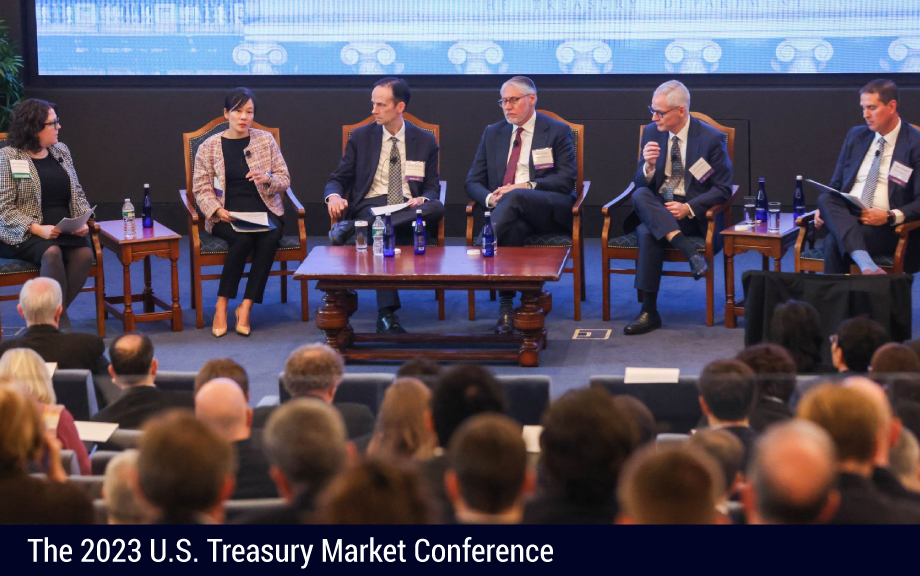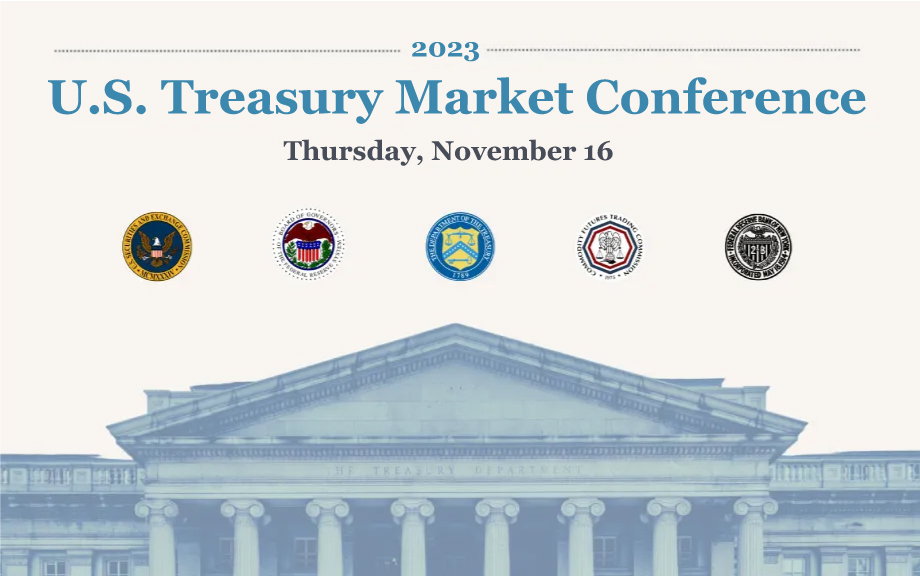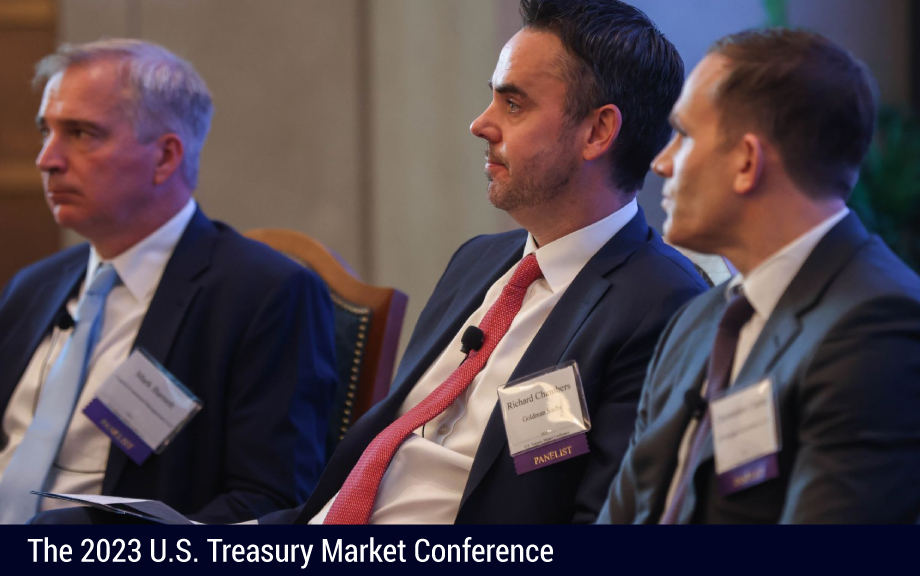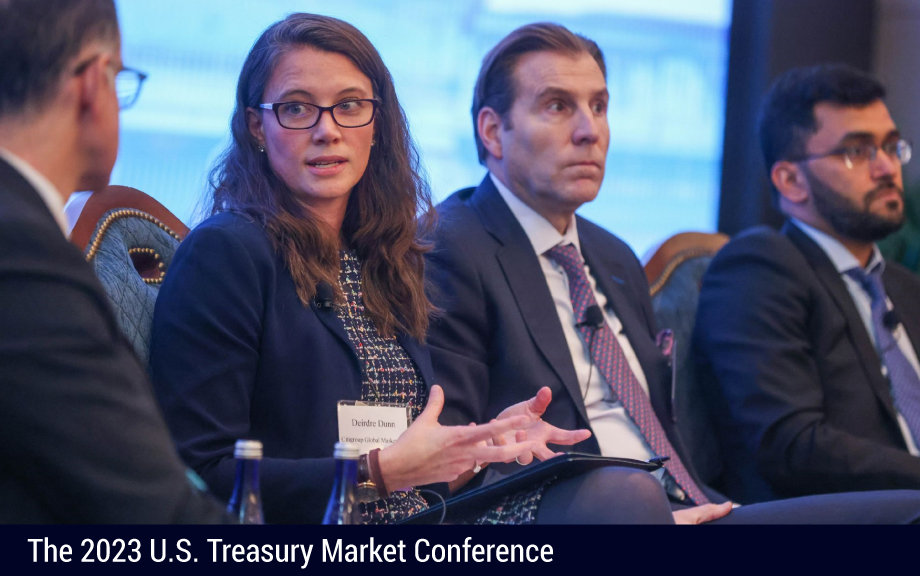
At the ninth annual U.S. Treasury Market Conference, Ellen Correia Golay, from the Markets Group at the New York Fed, moderated a panel on Treasury market resiliency and liquidity. The discussion, on November 16, 2023, considered the recent performance of the Treasury market amid higher volatility. It looked particularly at trading behavior, market resiliency, and liquidity, as well as potential initiatives to bolster the market’s resilience. The panel included representatives from a primary dealer, a hedge fund, an asset manager, a principal trading firm (PTF), and the New York Fed.
Recent Liquidity Conditions
Panelists noted that liquidity conditions during the tightening cycle have been challenged, but overall, the level of liquidity has remained consistent with what would be expected given the current high levels of volatility. This is particularly true in policy-sensitive tenors, given elevated uncertainty about the path of Fed policy in recent years. Some panelists noted liquidity conditions in near-dated Treasury securities improved somewhat in the latter portion of 2023, consistent with growing market certainty about the Fed’s path for policy rates. On the other hand, longer-dated Treasury securities experienced deteriorating liquidity in mid-2023 as yields rose substantially. Despite these challenged liquidity conditions, the dealer representative noted that the market continues to function well.
Market Structure and the Buyers of Treasury Securities
With respect to trends in positioning and trading over the last year, a panelist noted an increase in buyers’ price sensitivity, highlighting a transition from less price-sensitive buyers (including the Fed, foreign reserve managers, and banks, to some degree), toward more price-sensitive buyers (including asset managers, hedge funds, and retail investors). The heightened volatility and overall rise in yields in the latter half of 2023 could have been driven in part by the need for such price-sensitive buyers to absorb the increasing supply of Treasury securities. The panelist from the PTF noted that, while each firm is unique, their firm had embraced the volatility and continued to intermediate during volatile episodes.
Assessing the Resiliency of the Market
Despite recent elevated and episodic volatility, panelists highlighted the U.S. Treasury market’s ability to withstand such shocks. Some attributed the resiliency, particularly during the U.S. banking episode in March 2023, to adequate funding through the repo market and the confidence the Fed’s Bank Term Funding Program instilled in the market. Others noted that market participants were utilizing better capital risk models, and that appropriate hedging was in place during recent volatility episodes. Comparing market turbulence during the 2023 U.S. banking episode to the 2020 onset of COVID, panelists noted that dealers did not face the same balance sheet or intermediation capacity constraints in 2023 as they did in 2020. One noted the episodes were distinct in that 2023 centered around a repricing-type shock, while the market in 2020 faced massive selling across participants, with dealer balance sheets becoming overwhelmed. One panelist also noted that the establishment of the FIMA repo facility and Standing Repo Facility should improve the market’s capability to withstand another 2020-like “dash for cash” event.
Enhancing Resiliency Going Forward
Most panelists agreed that increased data transparency and improved dealer balance sheet capacity are critical to making the Treasury market even more resilient. While the size of the Treasury market has grown notably over the last decade, some argued that dealer intermediation capacity has not kept pace. One panelist suggested that adjustments to Basel III-related supplementary leverage ratio requirements and/or the broader adoption of central clearing were potential tools to improve dealer balance sheet and intermediation capacity. Other measures mentioned as possibly increasing the Treasury market’s resilience included the greater adoption of all-to-all trading and widening the access to official sector programs, like Fed purchases and Treasury buybacks. Some highlighted the significance of sequencing efforts. For instance, increased data and transparency could provide a better diagnosis of risks in the current market structure before turning to implementing other proposals. Lastly, it was also mentioned that central clearing could pave the way for wider natural adoption of all-to-all trading.
Tomorrow, in an accompanying article, we will share key takeaways from the panel on the future of the Treasury cash market.
A replay of this panel is available on the 2023 U.S. Treasury Market Conference event page, starting 2 hours, 26 minutes and 39 seconds into the embedded video.
Ellen Correia Golay is a capital markets trading advisor in the Markets Group.
Brian Greene is a capital markets trading associate director in the Markets Group.
Sara Kaddoura is a capital markets trading associate in the Markets Group.
Brett Rose is a capital markets trading director in the Markets Group.
Also in this series:
The views expressed in this article are those of the contributing authors and do not necessarily reflect the position of the New York Fed or the Federal Reserve System.













